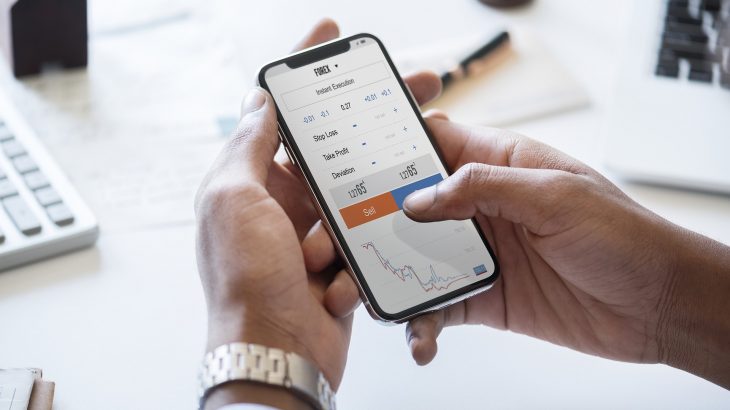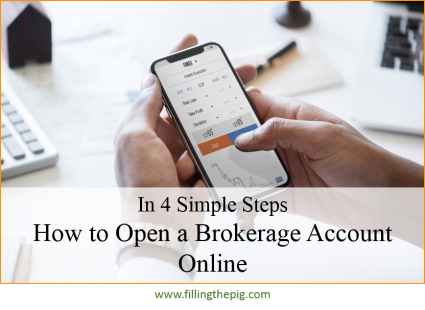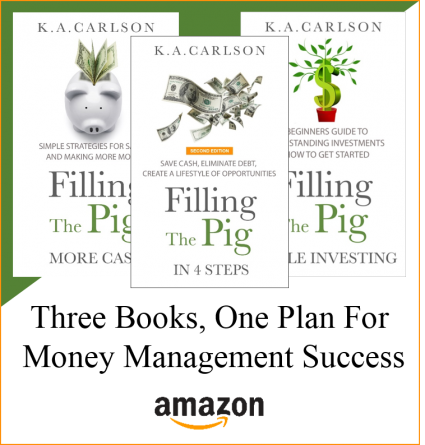I opened my first online brokerage account over 10 years ago. It was through my local bank. They were offering 100 free trades a year if I linked my checking account with their brokerage services. I had always wanted to open a brokerage account online, so I took advantage of the opportunity.
I hadn’t planned on doing a lot of trading, but then came the 2008 Recession and the stock market became very volatile. While others were pulling money out of the stock market, I felt it was a good opportunity to test my novice trading skills. From 2009 through 2010 I actively traded energy stocks. Call it luck, great timing or maybe both, but my first online trading experience proved to be very profitable.
If you have considered opening an online brokerage account, but have yet to do so. You may be experiencing some of the feelings I had before I opened my first account.
First, understanding the process of how to actually open a brokerage account online. How hard is it?
Second, in order to open an account, you have to commit some of your hard earned money to trade. And of course, by doing so, you have no guarantee that you won’t lose all of it.
I overcame the latter, by investing a small amount of money. I took an approach that I would only start trading with what I could afford to lose. As far as the first reason, I never really had anything to worry about. Opening an online brokerage account is super easy.
If you are considering opening an online brokerage account, don’t let the process stop you. Here’s how to open a brokerage account online, and the things you should consider before you do.
#1 Choose an Online Broker
In the past, there were clear distinctions between the different types of brokerage firms. And the products and services they provided their clients. However, over the years the line between a full-service company and an online firm have blurred. Much of this has been a result of technology. Trading platforms have made it easy for any brokerage firm to offer online trading.
However, there are still some differences between the providers in how they market their products and services to each individual investor.
Before you open an online brokerage account, consider the type of investments you will be investing in and how involved you want to be managing those investments.
I personally categorize online brokerage firms into these three categories.
Investment Firms
Companies like Vanguard, T. Rowe Price and Fidelity are asset management firms that provide online trading. Some large banks like Wells Fargo and Bank of America (Merrill Lynch) also provide online brokerage services. These types of companies not only provide online trading but a portfolio of their own investment products. Products like mutual funds and ETFs.
Consider a brokerage account with these firms if:
- Your primary investment of choice is funds – mutual funds, bond funds or ETFs.
- You have a personal preference based on a firm’s past performance with the investments they manage. For example, I currently have a brokerage account with T. Rowe Price. My first experience with T. Rowe Price was years ago through a 401(k) plan. I liked the performance of their target date funds. So, I opened a separate brokerage account with them to invest in some of their 4/5 star rated mutual funds.
- Your comfortable making your own online transactions. Personalized advice on investments is often a premium service for these companies. Unless of course your investing in their portfolio of investments.
In general, these firms are not the place to open an online brokerage account if your goal is to actively trade stocks and other individual securities. Although some firms will allow you to do so, trading fees are often higher than discount brokerage companies.
Discount Online Brokers
E*TRADE and TD Ameritrade are examples of discount online brokerage firms. Companies like these originated based on the growth of online trading, technology and a demand by the average investor for simple trading services.
Consider a Discount Broker if:
- Your trading will be self-directed – you’re going to do it all by yourself.
- Want the ability to trade a variety of securities. Stocks, mutual funds, bonds – regardless of what company or firm manages the investment. For example: via a discount brokerage firm you can purchase mutual funds from Vanguard and T. Rowe Price.
- Lowest possible transaction fees for a trade. (buy or sell)
Discount brokerage firms are by far the most popular for individuals who wish to actively make and manage their own investment transactions.
Robo-Advisors
These companies provide investors with a pre-set investment strategy. As the name suggests, robo-advisors or automated advisors use technology to pre-select, rebalance and manage the investments in a portfolio. Using technology allows them to minimize management fees for their investors.
For example, if your investment plan is a growth strategy, the portfolio you invest in may have a heavy concentration of stocks versus bonds. The robo-advisor would select a predetermined set of stocks, mutual funds or ETFs to meet your growth requirements.
I recently opened a Wealthsimple brokerage account, selecting a growth strategy based on my retirement timeline. Wealthsimple used a combination of Vanguard ETFs to meet my requirements. By automating the investment selection and using Vanguard ETFs Wealthsimple is able to keep their management fees low.
Acorns is another example of a robo-advisor. They focus on automated investing by rounding up the spare change in your checking, savings or credit card accounts. Personal Capital provides automated investing as well. In addition, they provide a wealth of financial resources including, retirement planning, tax help, and a personal financial advisor.
Consider opening a robo-advisor online account if:
- You prefer to have your investments pre-selected for you based on your overall investment strategy.
- Don’t want to have to manage your investments. You prefer a “set it and forget it” investing strategy. Your involvement is minimal.
- You want to invest automatically (direct deposit) and have the robo-advisor manage your distributions to different strategies or securities.
The use of technology by robo-advisors has created a lot of flexibility and simplicity for investors. Each robo investing platform is different. Be sure you understand how their technology works to meet your investment strategy.
If you are interested in starting your online experience with a robo-advisor I highly recommend Wealthsimple. I opened my account with $1000, although they have no minimum to start investing. And they do provide a real live person for financial advice. Learn more about Wealthsimple here.
#2 Costs
The costs associated with opening an online brokerage account can vary depending on the firm and the investment value of your account. Most costs will fall into these three categories.
Management Fees
These fees are assessed based on the value of the portfolio of assets you purchase.
For example:
- Robo-advisors will generally charge a management fee based on the dollar value of your portfolio. Most offer a tiered cost structure, the more money you invest the lower the fee. These are generally annual fees that are prorated and charged on a monthly basis.
- Discount brokers will have no management fees for their self-directed trading platform, however, have a fee for their premium services.
- Investment Firms generally do not charge a management fee if you are investing in their portfolio of assets. Premium services are also available from these companies.
Management fees are in addition to any expense ratios or internal expenses associated with the individual security. Like the expense ratio of a mutual fund or ETF.
When selecting a brokerage account, be sure you understand the management fees you’re paying and what you’re getting for the cost.
Transaction Costs
A transaction cost or trading fee are the costs associated with buying and selling a stock, mutual fund, ETF…a security. These transaction costs can range from $2.95 a transaction to as much as $50.
In addition to the trading fees, be sure you understand the transaction cost of individual securities. In some cases, trading a mutual fund will cost you more than trading a stock. Some mutual funds come with a redemption fee. A redemption fee is the fee charged if a mutual fund is purchased and then sold within a specific time period (i.e. 90 days). Redemption fees are designed to discourage short-term trading of a mutual fund.
Account Minimums
Depending on the brokerage firm, there may be an account minimum to open up an account. Funding an account with less than the minimum may incur additional fees, or as discussed above garner a higher management fee. In some cases, it may be a one-time service fee.
Inevitably, fees associated with your online account will impact the net return of your investments. Be sure you understand what the brokerage firm is charging to provide their online trading services.
#3 Advice and Broker Resources
This is one area that is consistently changing for all brokerage firms. Regardless of the company you’re working with be sure you understand what resources – free or paid that you have access to.
Consider:
- Personal Service: can you talk to a real live person to discuss investments, tax considerations or retirement planning?
- Do they provide investment research and performance data?
- Mock trading platforms: some companies provide mock trading platforms that allow you to trade without money to test your investment assumptions.
- Online Training Seminars: some companies will provide online training sessions that you can participate in to learn about investments, investing or financial strategies.
- Do they provide a mobile app?
- Training Videos: provide a library of training videos that tackle common questions or subjects about investing.
- Other Financial Services – Certificate of Deposit accounts, IRA accounts, Tax help, retirement planning are just some of the other services that may be offered.
As the financial space gets more and more competitive these types of ancillary services will become more common and robust. Why? Because everyone wants your money and this is one area where they can differentiate themselves from their competition.
If your plan is to do your own investing online, check to make sure you have access to the free services that can provide you with some guidance.
#4 How to Open a Brokerage Account Online – Super Simple
Fund or funding is the term used to put money in your brokerage account. If you have made it through steps 1-3, then this step is easiest. Once you determine how much money you’re going to start with, follow the steps below to open up your account.
- Locate the brokerage firms “Open an Account” icon.
- Personal Information: All brokerage companies will require detailed personal information to open an account and verify you are you. A log-on ID and password for your account, name, address and phone number. And be prepared to provide your social security number or driver’s license number.
- Funding Your Account: Once you have your personal information entered, you will then be asked how you want to fund the account. Electronic Funds Transfer (EFT) from your checking or savings account to your new brokerage account is one option. Wire transfers are also available and are the fastest way to get money from your bank account to your brokerage account. For both EFT and Wire Transfers you will need to provide your account number and bank routing number. Most brokerage firms will also accept checks. This step will also provide you with an opportunity to set up the frequency of a transfer. If you want to contribute to your account on a regular basis, or if you are only making a one-time deposit to your account.
- Cash/Money Market Account: Once the brokerage firm receives your funds (2-5 days) they will generally be deposited into your brokerage account via a cash account, i.e. savings or money market account. As you buy and sell securities money is moved back and forth between the cash account and your investments.
- Start Trading
Finally
Since opening my first online brokerage account I have added three additional accounts. I did this because it allows me to diversify my investment strategy by using different brokers, securities and trading platforms.
If managing your own investments is your goal, don’t let the process of opening an online account stop you. Start somewhere, start with a small investment, and learn. If in the future you decide you no longer want an online account, you can simply sell your investments and close the account down.
Helpful Resources:
- More FTP simple investing articles can be found here.
- Motley Fool Stock Advisor
- Wealthsimple – Socially Responsible Automated Investing $0 Account Minimum
- Personal Capital – All Your Financial Tools in One Place
- Acorns – Automatically invest your spare change.
Do you have a favorite online brokerage firm? Comment below.
Sign up for a Kindle Unlimited Free 30 Day Trial and read the complete Filling The Pig finance series of books for free.


